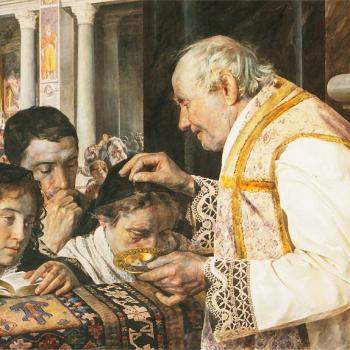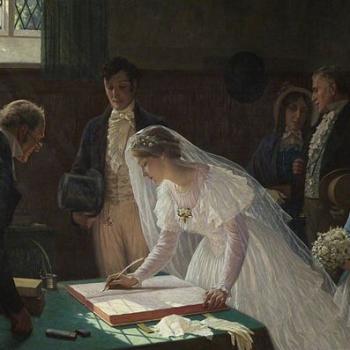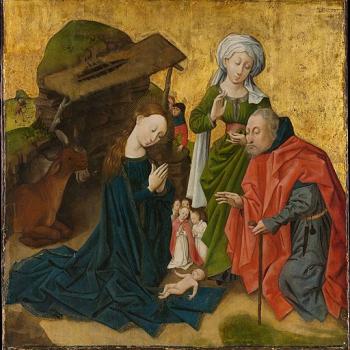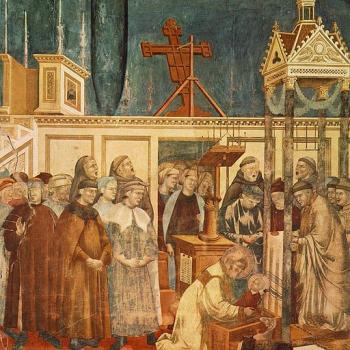In my first post on vocations I suggested a different way to think about the crisis in priestly vocations: reframe the numbers needed by localizing to the level of individual parishes. I do not think that this quantification (one vocation per parish every five years) will solve the problem, but I think that it serves two goals. First, it makes the problem seem more tractable. Second, it refocuses attention to the local level in a way which, I hope, makes the problem seem the responsibility of the whole community, priests and laity.
In this post I want to continue the discussion on recruiting young men to the priesthood by considering images of the priesthood. If we are going to ask young men to become priests, we need to give some thought to how we describe what we are asking them to become. What does it mean to be priest? Who are priests? Many young men have only had close contact with only a small handful of priests. Thinking of my own sons: they have known two parish priests and have met a couple of religious order priests (friends of my wife and me). I suspect that for most young men, media images—some from Catholic media but many more from secular sources—has shaped their conception of priests and the priesthood. The resulting image is not always a positive: one need only consider the pedophilia scandal, which has created a very negative image of priests, one which distorts the impressions of even devote Catholics. (I recall a man I met who would not let his daughter be with his pastor unless he was physically present, even in a group setting with other adults present.)
The problem is further compounded by the very different understanding of priests held by different groups within the Church. One need look no further than the commboxes of Vox Nova for evidence of this. Though over-simplifying matters a great deal, one axis on which things polarize is the disjunction between “Vatican II priests” and “John Paul II priests“. And then, to make matters more interesting, we have Pope Francis bringing his own perspective to the mix, discussing the “so-called crisis of priestly identity” with simple, direct images that are both evocative and challenging:
This is precisely the reason why some priests grow dissatisfied, become sad priests, lose heart and become in some sense collectors of antiques or novelties – instead of being shepherds living with “the smell of the sheep”, shepherds in the midst of their flock, fishers of men.
I want to begin a discussion of what we want our priests to be by looking at a few visual images of priests. Such visual representations are in themselves not the whole story: indeed, they reside in a context which gives them multiple meanings and interpretations. Nevertheless, we live in a society dominated by the visual, and images will be one way in which we encourage young men to explore vocations to the priesthood. So we need to decide on what they should see and what meaning(s) we want these images to carry.
The following image was widely distributed and in my archdiocese seemed to have semi-official status: a holy card of St. John Vianney (patron saint of parish priests) that was circulated in 2009-2010 as part of the Year for Priests proclaimed by Benedict XVI.
To be brutally (and perhaps controversially) frank: I really do not like this image. It is supposed to convey a sense of the deep spiritual life of the saint, but instead I see an old man in his night gown. Thinking back to when I was trying to discern whether I had a priestly vocation, I am sure that I would not have seen myself in this picture, and I have a hard time believing that this picture would connect with most young men today. To forestall objections: yes, some young men will respond positively to this picture, but I suspect that they will come from the small minority of Catholic families that emphasize traditional practices and imagery. In other words, they are already shaped by a particular milieu which leads them to interpret the symbolism of this picture (kneeling many in robes, rosary, monstrance) in a particular way. To confirm this impression, I asked my son Francisco (who has previously had a guest post about images of Jesus). Though probably not typical of his generation, he does have a fairly keen sense of what motivates his confreres. He found it “stuffy” and “overly formal” and not anything that speaks to him.
On a more objective level, I believe that this picture reduces the life and vocation on St. John Vianney to his personal holiness. His holiness is no small thing, but we are all—clergy and laity—called to be holy and to have deeper prayer lives. It says nothing about his vocation as a priest except for the image of a confessional in the left background, something I actually overlooked until I studied this image closely while writing this post. What distinguishes St. John Vianney as a priest—his work as a teacher, a preacher, a confessor and spiritual director—is either not present or minimally represented. As his long ministry shows, the work of a priest, particularly a parish priest, is social: it involves interacting with people in a variety of settings. John Vianney himself said that “The priesthood is the love in the heart of Jesus” and Pope Benedict described this love in interpersonal and communal terms:
The pious excess of his devout biographer should not blind us to the fact that the Curé also knew how to “live” actively within the entire territory of his parish: he regularly visited the sick and families, organized popular missions and patronal feasts, collected and managed funds for charitable and missionary works, embellished and furnished his parish church, cared for the orphans and teachers of the “Providence” (an institute he founded); provided for the education of children; founded confraternities and enlisted lay persons to work at his side.
Given this life and ministry, I think it was a mistake to represent the saint with an image that is redolent of “the pious excess of his devout biographer.”
While trying to find other images of the priesthood that I thought were better, I stumbled upon another image that went too far in the other direction.
The format is a movie poster, and the symbolism is drawn from The Matrix. When I first saw it my reaction was that it was am attempt to recruit hipster priests: “I joined the clergy before it was cool.” My son Francisco strongly disagreed. He said that the cassock looked “cool” (he has only seen one priest wearing a cassock) but overall he felt that the poster was “trying too hard”. Moreover, and more to the point, he felt that it didn’t present a realistic or appealing image of the priesthood. I agree: there comes a point that the priesthood is made so “relevant” that it has no relevance.
How then to navigate between these two extremes? What are the images that we want to use? I would suggest that we need a variety of images, all of them linked to provide a narrative: tell who priests are by showing what they do in their daily lives. Previously, I blogged about a French priest whose daily life revolved around meeting the needs of people. Now I want images that capture, in the American context, this sense that a man lives out his vocation as a priest in relationship with other people. From the Diocese of Richmond I found a very nice summary of the priesthood in these terms.
What does a priest do all day?
What a priest does with his day is so varied and complex that only a sampling can be given here. Prayer, work, exercise and leisure are all necessary for a healthy life. We try to make sure we have a balance of all these – but we don’t always succeed.In the area of work (ministry), many of us have one main occupation, such as teaching, parish ministry, social work, or hospital work, all of which have somewhat regular hours and predictable demands.The unpredictable demands are also interesting and challenging. They center on meeting the needs of people: the sick, old, angry, hurt, hungry, imprisoned, excited, happy. We share with them our understanding, encouragement, and support. We rejoice, cry, and celebrate with them. Such events are both painful and rewarding, fatiguing and empowering.
A central role for priests is to be priests: ministers of the sacraments. However, I believe that this is also to be understood in terms of relationship and community: while masses “sine populo” are still allowed, they have become increasingly rare, and since Vatican II there has been a renewed emphasis on the role of the congregation in celebrating the mass. Moreover, the other sacraments and rites—baptisms, weddings, confessions, annointing, funerals, blessings of all kinds—are, by their very nature, done in relationship with others. And this, I believe, is what we should present to young men as something to aspire to. They should be asked: do you want to live a life in service of others: to teach, to preach, to comfort, to be with your brothers and sisters in their joys and sorrows? The following are a few images quickly snatched from the web, to illustrate this. They are not ideal, but are chosen to reflect this ideal of relationship.
I want to close this post with a question and a final image. What images would you use to to frame the priesthood in order to attract young men to consider if this is their vocation? While your answers to this question will depend strongly on your understanding of the priesthood, please try to frame your response in terms of images.
As a final thought, here is a picture that I found while browsing for images of the priesthood. I include it because I find it very moving, and one which I think might stir something in the hearts of young men who dream big. A young Francis was enamored by stories of knights and chivalry, and for many years interpreted his own vocation in these grand terms. This image would allow young men to see themselves in equally heroic terms:
This is a picture of Archbishop Oscar Romero, taken a few minutes after he was murdered while saying mass. For me it captures the sacrificial self-giving that lies at the heart of any Christian vocation:
My command is this: Love each other as I have loved you. Greater love has no one than this: to lay down one’s life for one’s friends. You are my friends if you do what I command. (John 15:12-14)
——–
Coda: I asked my son Francisco about this picture of Romero, and while he admires the story, he found it too grim to use as a recruiting tool for vocations to the priesthood.



















